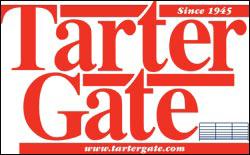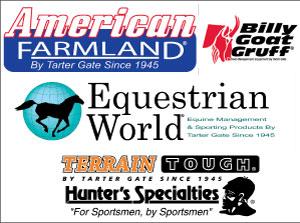Contributing Writer
- FMA
- The Fabricator
- FABTECH
- Canadian Metalworking
Categories
- Additive Manufacturing
- Aluminum Welding
- Arc Welding
- Assembly and Joining
- Automation and Robotics
- Bending and Forming
- Consumables
- Cutting and Weld Prep
- Electric Vehicles
- En Español
- Finishing
- Hydroforming
- Laser Cutting
- Laser Welding
- Machining
- Manufacturing Software
- Materials Handling
- Metals/Materials
- Oxyfuel Cutting
- Plasma Cutting
- Power Tools
- Punching and Other Holemaking
- Roll Forming
- Safety
- Sawing
- Shearing
- Shop Management
- Testing and Measuring
- Tube and Pipe Fabrication
- Tube and Pipe Production
- Waterjet Cutting
Industry Directory
Webcasts
Podcasts
FAB 40
Advertise
Subscribe
Account Login
Search
Establishing an identity
Tube producer/fabricator devises market, branding strategy for growth
- By Stephanie Vaughan
- February 13, 2007
- Article
- Shop Management

Although Tarter Gate already had established a reputation for making gates and fences, five years ago the company decided it was time to delve into marketing and branding.
Steeped in agriculture, the Tarters did what many families do: They turned their passion into their vocation.
But when C.V. Tarter founded Dunnville, Ky.-based Tarter Gate in 1945, his first thought may not have been of marketing plans and business strategies. His goal likely was simpler than that — to peddle his handmade gates and fences to local farmers.
Over time the company has evolved, making not only wooden gates and fences, but also products made from metal pipe — pipe that the company produces itself with its three tube mills.
Although Tarter Gate's mission today still is to give its customers the best animal management and farm equipment it can make, over time the company realized that to keep growing, it needed to specify its goals and ways to meet these goals.
That's when the terms marketing strategy and branding took on real meaning for the company — and made a difference in its growth and future.
Marketing Makes Its Mark
Five years ago Tarter Gate realized that it hadn't done a good job of promoting itself, especially on a national level, according to Travis Cox, Tarter Gate's vice president and general manager.
"We needed to create and promote a central image as part of a marketing strategy," Cox said.
At the time the company could say that it produced more than 400 products, but it was known as a gate manufacturer, so customers didn't necessarily realize that other Tarter Gate products were available too.
And although company growth usually isn't considered a bad thing, for Tarter Gate it posed some challenges.
By this time the company had grown large enough that big farm and ranch store chains started to consider selling its products. But Tarter Gate didn't know how to answer one of the first questions retail chains asked: How do you advertise your products?

Creating distinct brands for each group of products it manufactures helped Tarter Gate grow and expand nationally.
After being asked similar questions several times, the company realized that this was a component of the business that it needed to investigate to keep growing. Then Tarter Gate was referred to The Idea Farm, a marketing, advertising, and public relations firm in Danville, Ky.
The first step in the process was to establish a strategy for Tarter Gate, said Ron Jackson, president of The Idea Farm. To do this, Tarter Gate needed to decide if its goal was to sell the business, grow it, or create a succession plan. Tarter Gate wanted to continue growing between 15 percent and 25 percent a year.
The Idea Farm visited Tarter Gate's customers — buyers, store managers, and people who made decisions about what products to sell in their stores. This marked the beginning of a study, which Jackson said usually takes three to five months to complete, that resulted in a 190-page report with 1,000 pages of support material that would help steer Tarter Gate in the right direction.
"One of the things that kept coming up was that Tarter Gate didn't have a marketplace identity," Jackson said. "They [customers] buy something else and then they end up seeing the product by accident."
To give the company more exposure in the marketplace, Jackson said the next step was to start branding its products.
A New Brand Approach
Together Tarter Gate and The Idea Farm brainstormed names and ideas for branding products.
Overall, the branding process needed to enable the company to promote itself as a national player. Breaking out its product lines and branding them were critical.
"The marketing strategy was to take what was a very large product mix and segment it into more understandable pieces," Cox said.
Jackson broke the products down into categories and started throwing out ideas about names that would best fit these product segments.
For example, one of Tarter Gate's main product lines is for feeding and caring for traditional farm animals, mostly beef cattle. This product line would be called American Farmland®.
"We wanted something that was red, white, and blue to the core, that American farmers could wrap themselves around," Jackson said.
Next was the line of goat equipment. It was named Billy Goat Gruff®. "It was so obvious to me that this said rough and tough and all the things that the products were about," Jackson said. "Everyone loved it."
Then came a group of products made especially for horses, which had never been separated from the company's other offerings. Targeted to the average equestrian, this product line was branded Equestrian World®.
Tarter Gate also had a line of heavy-duty equipment designed for customers who grow game plots to attract animals for hunting purposes. Jackson said that this market, a significant one for Tarter Gate, needed a name that would attract hunters.
In the process of branding this product line, Tarter Gate attracted the interest of Cedar Rapids, Iowa, hunting accessory manufacturer Hunter's Specialties, and the two companies co-branded the line TerrainTough®/Hunter's Specialties®. This was a good move for Tarter Gate in the branding process, according to Jackson.
"That means a lot to hunters because they recognize Hunter's Specialties even if they haven't heard of Tarter Gate," he said.
Tarter Gate's decorative fencing line was called Secure Estate™ to promote the products' aesthetic image for commercial and residential fencing. And, finally, its dog kennels were branded with the Elite Kennel™ name.
Through branding, Cox said, the company could better identify its products to customers and potential customers.
"We can say we make a full line of goat-handling equipment, equine equipment, and so on, in identifiable segments. We could do targeted advertising and promotion in ATV magazines, equine magazines, and hunting magazines," Cox said. "We could spend our dollars a lot more efficiently because we had the various brands."
Planning for Growth
Although branding itself was a strategy for Tarter Gate, it was part of a marketing plan the company needed to achieve the growth it was aiming for.
To realize this growth, the company needed to expand, and Jackson felt that one way to do this was to open a facility out West, where demand would be high for the company's products.
Today the company's Box Elder County, Utah, manufacturing and distribution facility has bending, welding, fabricating, and powder coating capabilities and eventually will have its own tube mill. Except for its three-point farm equipment, all of the company's products are made there.
Another part of its expansion led the company to purchase a former OshKosh B'Gosh manufacturing facility in Liberty, Ky. Tarter Industries produces 38 different pieces of three-point equipment, including rotary mowers, hay spears, plows, landscape rakes, and fertilizer spreaders. This particular expansion came directly from dealers who expressed an interest in finding a new source for these products. Just a few years ago, Tarter Gate was making just four to six types of three-point equipment.
And to continue to reach customers, the company also realized that it needed a way to showcase its products, most of which would generally be seen outdoors rather than inside a store.
"If you're an average customer and you walk into the store, you don't see it," Jackson said. To bring more visibility to the brands, Tarter Gate started producing in-store displays that incorporate photos and laminates to showcase its products. So far the company has sold more than 1,000 of these displays to various retail outlets.
Cox said he has seen several benefits to marketing and branding Tarter Gate's products. The company has been able to sustain 20 percent growth, and its products continue to be purchased by large, national retail store chains, including Do It Best and Lowe's.
The opportunities Tarter Gate has gained can be tied directly to the branding and marketing strategies the company and its marketing firm created together, according to Cox.
"Once [the product lines] got their own identity, each line took on a life of its own and started to grow rapidly. When you offer a full branded line of goat products, the line grows very quickly, and this happened in each of the lines," he said.
Product growth also has allowed the company to become more of a one-stop shop for its vendors and customers.
Tarter Gate has expanded its image and place in the industry, which Cox said is an important part of meeting its goals for growth. With its marketing and branding efforts, the company can demonstrate its full range of products more effectively, Cox said.
"We stepped up our image and place in the industry," Cox said. "We have gate in our name, but if you look at our company, we're far more than a gate company."
The challenge now is to ramp up sales efforts to keep up with the manufacturing output of the company's two new facilities.
About the Author

About the Publication
subscribe now

The Tube and Pipe Journal became the first magazine dedicated to serving the metal tube and pipe industry in 1990. Today, it remains the only North American publication devoted to this industry, and it has become the most trusted source of information for tube and pipe professionals.
start your free subscription- Stay connected from anywhere

Easily access valuable industry resources now with full access to the digital edition of The Fabricator.

Easily access valuable industry resources now with full access to the digital edition of The Welder.

Easily access valuable industry resources now with full access to the digital edition of The Tube and Pipe Journal.
- Podcasting
- Podcast:
- The Fabricator Podcast
- Published:
- 04/16/2024
- Running Time:
- 63:29
In this episode of The Fabricator Podcast, Caleb Chamberlain, co-founder and CEO of OSH Cut, discusses his company’s...
- Trending Articles
Zekelman Industries to invest $120 million in Arkansas expansion

3D laser tube cutting system available in 3, 4, or 5 kW

Corrosion-inhibiting coating can be peeled off after use

Brushless copper tubing cutter adjusts to ODs up to 2-1/8 in.

HGG Profiling Equipment names area sales manager

- Industry Events
16th Annual Safety Conference
- April 30 - May 1, 2024
- Elgin,
Pipe and Tube Conference
- May 21 - 22, 2024
- Omaha, NE
World-Class Roll Forming Workshop
- June 5 - 6, 2024
- Louisville, KY
Advanced Laser Application Workshop
- June 25 - 27, 2024
- Novi, MI


























